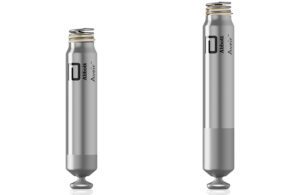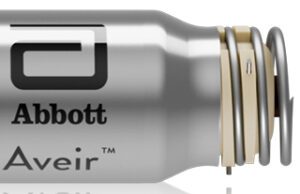
Abbot’s Aveir DR (left) and VR (right) leadless pacemakers communicate wirelessly with each other from different chambers of the heart. [Image courtesy of Abbott]
The lead engineer on Abbott’s Aveir project explains how his team developed a first-of-its-kind wireless pacemaker system that communicates through blood.
When Abbott’s Aveir DR pacemaker system became the first approved by the FDA for dual-chamber pacing this year, it expanded the benefits of leadless pacing to the majority of patients who need stimulation of both the atrium and ventricle chambers.
The lead engineer on the Aveir project, Matthew Fishler, was working on leadless pacemaker technology at Nanostim when it was acquired by St. Jude Medical in 2013. (Abbott then purchased St. Jude in 2017.) He traced the idea for a dual-chamber leadless system in an effort to eliminate lead failures and other complications of traditional pacemakers back to 2014.
They weren’t the only ones working on leadless pacemakers. In 2016, Medtronic’s Micra became the first leadless pacemaker to win FDA approval. Instead of a pacemaker implanted beneath the skin near the collarbone and connected to the heart with leads, the 25.9 mm-long Micra is placed directly inside the heart using a catheter.
But about 80% of pacing therapy patients need dual-chamber pacing. Abbott’s Aveir devices solve that problem.
Abbott won FDA premarket approval (PMA) for its Aveir VR single-chamber ventricular leadless implant in 2022, and followed with an FDA PMA in June 2023 for Aveir DR, the first leadless implant for the atrial chamber. Used together — with the Aveir VR in a patient’s right ventricular chamber and an Aveir DR in the right atrial chamber — the two implants communicate wirelessly with each other through blood and heart tissue.
How the Abbott Aveir DR system works

Abbott’s Aveir leadless pacemakers have a helix at one end to anchor to tissue inside the heart’s chambers. [Image courtesy of Abbott]
The Aveir name is an acronym: AV for atrial and ventricular, E for extended longevity, I for the “i2i” implant-to-implant communication system, and R for retrievable.
The Aveir VR right ventricle device is 38 mm long and 6.5 mm in diameter. The Aveir DR right atrium device is the same diameter but only 32.2 mm long. The team designed Aveir DR with a shorter length to avoid interference with the tricuspid valve that connects the right atrium with the right ventricle.
The catheter-delivered implants anchor into the heart tissue using a corkscrew-like helix. Inside the helix is a small tip electrode for sensing and pacing stimulation. A return electrode is at the opposite end of the device. The pacemakers generate electrical pulses to correct slow or irregular heartbeats and communicate with each other to coordinate their pacing.
The “solve-this-or-go-home” challenge
The biggest design decision at the very beginning was how to independently position the two devices in separate chambers to operate as well as a conventional, dual-chamber system with leads.

Matthew Fishler is Abbott’s chief engineer for leadless pacemakers. [Photo courtesy of Abbott]
“That was a huge challenge that we needed to tackle,” Fishler said in an interview with Medical Design & Outsourcing. “Way back in 2014 when we first started, that was our primary target: Solve this or we’re going home.”
The two devices needed to wirelessly communicate with each other with every heartbeat. Potential options like Bluetooth low energy (BLE), inductive or radiofrequency required more power than batteries inside the heart could provide.
The team spent six months brainstorming ideas and fast-failing to evaluate and eliminate options. Some of the “wacky” ideas included light pulses between the devices, but again the constraint was power.
“Through this iterative fast-fail process, we were able to relatively quickly home in on what worked and what didn’t,” Fishler said. “And [over] multiple refinement cycles, we came up with this approach that we now use.”
That approach is their new i2i conductive communication protocol, which uses the conductive properties of the heart’s blood and tissue to relay very small packets of information electronically between the devices. With each heartbeat, the devices send a 32-bit message with a header indicating whether the device sensed or paced and a payload with other key information.
The idea looked good on paper, so they modeled the technology with computers, built test chips and developed crude dummy devices they called submarines for testing in a fish tank filled with saline.
“Blood is very much a salt solution. … You can titrate out a saline solution to be very equivalent to what blood would be in terms of connectivity, so that’s exactly what we did,” Fishler said.
They used the longstanding C computer programming language for the device code and C++ for the software and the programmer.
“Especially for the software that’s in the device, the compilers for C are so effective and efficient, it generates very efficient code. It’s all about the efficiency, reducing the number of cycles that the micro has to run,” Fishler said.
That first evidence of feasibility in the fish tank was what Fishler called the “ah-ha moment.”
“You can’t believe how much we celebrated. It was a huge moment,” he said. “All of the dual-chamber function, all of the standard features that a clinician would expect to see out of a dual-chamber pacemaker system is built on top of our i2i protocol. Without that, we wouldn’t have a dual-chamber system, and we would certainly wouldn’t have a real-time dual-chamber system that could maintain this beat-to-beat synchronization across all different scenarios.”
Dual-chamber leadless lessons learned
When the Aveir team set out to adapt their ventricular chamber device for the atrium, the thinner atrial wall and more dynamic motion inside the chamber presented other design hurdles.
“We started by just taking what we learned, what we knew and loved in the ventricle, and applying it in the atrium. And then we quickly learned it was a little bit more challenging. … We had to essentially reinvent how the system engaged with the tissue in the atrium. It didn’t take a lot, but they were critically important. We made subtle changes to the fixation helix. And then we also changed the tip electrode from a passive or a dome tip electrode in the ventricle to an active inner helix for the atrial device. That was key to getting the stability in the atrial chamber so that we would get good, stable chronic threshold and chronic engagement in the tissue over time.”
The team also learned through development the importance of a protective sleeve over the entirety of the pacemaker as the device travels to a patient’s heart from their groin and up through their vasculature, helix-end-first. When the device reaches the site of implantation, the physician pulls the sleeve back.
“That’s really an important feature to mitigate against potential harm to the patient or potential damage to the device,” Fishler said. “The sleeve doesn’t open or close, it’s just extended to go past it, like a very flexible, very compliant cylinder. That’s sufficient. … We generally want to keep that open because we’re constantly flushing saline through the system to keep it open, keep it fresh and make sure no blood clots can form on the system.”
With the helix exposed for placement, a mapping feature built into the Aveir device and catheter allows the physician to use fluoroscopy for visualization of the endocardial chamber. Radiopaque markers allow the physician to navigate the pacemaker to target locations, where the device can take measurements by touch but before being screwed in. Those measurements — such as impedance or sense amplitude — help the physician determine the best spots to anchor the device, which they do by rotating the entire device to sink the helix into the heart tissue.
“Then they can confirm that their measurements are still good — and if not, for whatever reason, they can unscrew it and go back to another location,” Fishler said. “We give them a lot of flexibility to dynamically evaluate and reevaluate locations across the entire process of implantation.”
The Aveir pacemakers are designed to be retrievable not only to adjust placement right away, but in case they need to be removed and replaced some time after the procedure. Custom lithium-carbon monofluoride batteries from Integer power the implants — and take up a majority of the device’s volume to maximize capacity. The team optimized not only the physical electronics package, but also the functional aspects: minimizing background current just to keep the system on without pacing.
“We focused a lot on making it so much more efficient than a conventional system. We are generally about 10 times smaller in size than a conventional pacemaker, and about 10 times more efficient in background current as a conventional pacemaker,” Fishler said.
While Abbott hasn’t yet shared Aveir longevity data from its clinical trial, Fishler said the average longevity is more than 17 years for Abbott’s other single-chamber devices.
“This is a first-in-human, first-in-the-world system, so we learned a lot through the trial. For the engineers, we are taking all that knowledge and feeding it back into finding improvements, making improvements, and we will continue to iterate,” Fishler said.
And keep an eye out for other applications from Abbott for the i2i communication protocol. Fishler said his team is already exploring other opportunities to use it.
“We’re not in a position yet to really say where we’re going, but we’re using our imagination,” Fishler said. “We’re trying to see how we can leverage it because we really do think the concept of interbody communication between implanted medical devices has a lot of potential benefits beyond just this dual-chamber pacing system.”